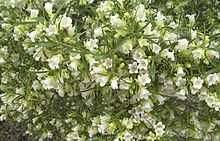Eremophila mitchellii
| Eremophila mitchellii | |
|---|---|
 | |
| Scientific classification | |
| Kingdom: | Plantae |
| (unranked): | Angiosperms |
| (unranked): | Eudicots |
| (unranked): | Asterids |
| Order: | Lamiales |
| Family: | Scrophulariaceae |
| Genus: | Eremophila |
| Species: | E. mitchellii |
| Binomial name | |
| Eremophila mitchellii Benth. | |
Eremophila mitchellii, known commonly as false sandalwood, is a shrub or small tree native to Australia. Other common names include budda, sandalbox, and rosewood belvory.[1]
Description
This species grows as a multi-stemmed shrub or small tree up to 10 metres in height. The leaves are linear to linear-lancelote and range between 2 and 6 cm in length and about 3 to 7 mm wide. It has white (occasionally pale pinkish-mauve) flowers with spots in the throat, which occur in the spring, and to a lesser extent, in the autumn.
Taxonomy
The species was first formally described in 1848 by the botanist George Bentham, who gave the specific epithet mitchellii in honour of explorer Thomas Mitchell.
Synonyms include:
- Bontia mitchellii (Benth.) Kuntze
- Pholidia mitchellii (Benth.) Wettst.
Distribution
The species occurs within a variety of vegetation communities in Queensland and New South Wales.
Weed status
In some areas of Australia the species is considered to be an invasive weed on grazing land and is prohibited from cultivation in Western Australia.
References

- ↑ Trees of Australia. Victorian Woodworkers of Australia 9 list: Q-R-S
- "Eremophila mitchellii (Benth.)". Australian Plant Name Index (APNI), IBIS database. Centre for Plant Biodiversity Research, Australian Government.
- PlantNET: New South Wales Flora Online: Eremophila mitchellii
- Association of Societies for Growing Australian Plants (ASGAP): Eremophila mitchellii